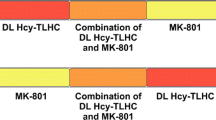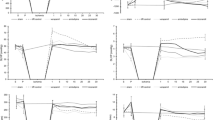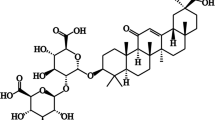Abstract
The role of N-methyl-D-aspartate receptor (NMDA-R) in heart is still unclear. For these ionotropic glutamate receptors is characteristic the necessity of both co-agonists, glutamate and glycine, for their activation, which primarily allows influx of calcium. The aim of the present study was to examine the effects of verapamil, as a calcium channel blocker, alone and its combination with glycine and/or glutamate on cardiac function, coronary flow, and oxidative stress in isolated rat heart or to examine the effects of potential activation of NMDA-R in isolated rat heart. The hearts of male Wistar albino rats were excised and perfused according to Langendorff technique, and cardiodynamic parameters and coronary flow were determined during the administration of verapamil and its combinations with glutamate and/or glycine. The oxidative stress biomarkers, including thiobarbituric acid-reactive substances, nitrites, superoxide anion radical, and hydrogen peroxide, were each determined spectrophotometrically from coronary venous effluent. The greatest decline in parameters of cardiac contractility and systolic pressure was in the group that was treated with verapamil only, while minimal changes were observed in group treated with all three tested substances. Also, the largest changes in coronary flow were in the group treated only with verapamil, and at least in the group that received all three tested substances, as well as the largest increase in oxidative stress parameters. Based on the obtained results, it can be concluded that NMDA-R activation allows sufficient influx of calcium to increase myocardial contractility and systolic pressure, as well as short-term increase of oxidative stress.




Similar content being viewed by others
References
Abd Allah ES, Ahmed MA, Abdel Mola AF (2014) Comparative study of the effect of verapamil and vitamin D on iron overload-induced oxidative stress and cardiac structural changes in adult male rats. Pathophysiology 21:293–300
Abernethy DR, Schwartz JB (1999) Calcium-antagonist drugs. N Engl J Med 341:1447–1457
Ago T, Kitazono T, Ooboshi H, Iyama T, Han YH, Takada J, Wakisaka M, Ibayashi S, Utsumi H, Iida M (2004) Nox4 as the major catalytic component of an endothelial NAD(P)H oxidase. Circulation 109(2):227–233
Arora S, Kaur T, Kaur A, Singh AP (2014) Glycine aggravates ischemia reperfusion-induced acute kidney injury through N-methyl-D-aspartate receptor activation in rats. Mol Cell Biochem 393(1–2):123–131
Auclair C, Voisin E (1985) Nitroblue tetrazolium reduction. In: Greenvvald RA (ed) Handbook of methods for oxygen radical research. CRC Press Une, Boca Raton, pp. 123–132
Bedard K, Krause KH (2007) The NOX family of ROS-generating NADPH oxidases: physiology and pathophysiology. Physiol Rev 87(1):245–313
Boyman L, Williams GS, Lederer WJ (2015) The growing importance of mitochondrial calcium in health and disease. Proc Natl Acad Sci U S A 112(36):11150–11151
Bozic M, Valdivielso JM (2015) The potential of targeting NMDA receptors outside the CNS. Expert Opin Ther Targets 19:399–413
Díaz-Flores M, Cruz M, Duran-Reyes G, Munguia-Miranda C, Loza-Rodríguez H, Pulido-Casas E, Torres-Ramírez N, Gaja-Rodriguez O, Kumate J, Baiza-Gutman LA, Hernández-Saavedra D (2013) Oral supplementation with glycine reduces oxidative stress in patients with metabolic syndrome, improving their systolic blood pressure. Can J Physiol Pharmacol 91:855–860
Elliott WJ, Ram CV (2011) Calcium channel blockers. J Clin Hypertens (Greenwich) 13:687–689
Faruk Akturk I, Arif Yalcin A, Biyik I, Sarikamis C, Turhan Caglar N, Erturk M, Celik O, Uzun F, Murat Caglar I, Oner E (2014) Effects of verapamil and adenosine in an adjunct to tirofiban on resolution and prognosis of no reflow phenomenon in patients with acute myocardial infarction. Minerva Cardioangiol 62:389–397
Froh M, Thurman RG, Wheeler MD (2002) Molecular evidence for a glycine-gated chloride channel in macrophages and leukocytes. Am J Physiol Gastrointest Liver Physiol 283:856–863
Ganguly P, Alam SF (2015) Role of homocysteine in the development of cardiovascular disease. Nutr J 14:6
Gao X, Xu X, Pang J, Zhang C, Ding JM, Peng X, Liu Y, Cao JM (2007) NMDA receptor activation induces mitochondrial dysfunction, oxidative stress and apoptosis in cultured neonatal rat cardiomyocytes. Physiol Res 56:559–569
Gill SS, Pulido OM, Mueller RW, McGuire PF (1998) Molecular and immunochemical characterization of the ionotropic glutamate receptors in the rat heart. Brain Res Bull 46:429–434
Glass MJ, Wang G, Coleman CG, Chan J, Ogorodnik E, Van Kempen TA, Milner TA, Butler SD, Young CN, Davisson RL, Iadecola C, Pickel VM (2015) NMDA receptor plasticity in the hypothalamic paraventricular nucleus contributes to the elevated blood pressure produced by angiotensin II. J Neurosci 35:9558–9567
Green LC, Wagner DA, Glogowski J, Skipper PL, Wishnok JS, Tannenbaum SR (1982) Analysis of nitrate, nitrite, and [15 N]nitrate in biological fluids. Anal Biochem 126:131–138
Grossman E, Messerli FH (2004) Calcium antagonists. Prog Cardiovasc Dis 47:34–57
Hama-Tomioka K, Kinoshita H, Nakahata K, Kondo T, Azma T, Kawahito S, Hatakeyama N, Matsuda N (2012) Roles of neuronal nitric oxide synthase, oxidative stress, and propofol in N-methyl-D-aspartate-induced dilatation of cerebral arterioles. Br J Anaesth 108:21–29
Hayakawa T, Kunihiro T, Ando T, Kobayashi S, Matsui E, Yada H, Kanda Y, Kurokawa J, Furukawa T (2014) Image-based evaluation of contraction-relaxation kinetics of human-induced pluripotent stem cell-derived cardiomyocytes: correlation and complementarity with extracellular electrophysiology. J Mol Cell Cardiol 77:178–191
Joseph LC, Barca E, Subramanyam P, Komrowski M, Pajvani U, Colecraft HM, Hirano M, Morrow JP (2016) Inhibition of NAPDH oxidase 2 (NOX2) prevents oxidative stress and mitochondrial abnormalities caused by saturated fat in cardiomyocytes. PLoS One 11(1):e0145750
Kalinina N, Agrotis A, Tararak E, Antropova Y, Kanellakis P, Ilyinskaya O, Quinn MT, Smirnov V, Bobik A (2002) Cytochrome b558-dependent NAD(P)H oxidase-phox units in smooth muscle and macrophages of atherosclerotic lesions. Arterioscler Thromb Vasc Biol 22(12):2037–2043
Kanani PM, Sinkey CA, Browning RL, Allaman M, Knapp HR, Haynes WG (1999) Role of oxidant stress in endothelial dysfunction produced by experimental hyperhomocyst(e)inemia in humans. Circulation 100(11):1161–1168
King N, McGivan JD, Griffiths EJ, Halestrap AP, Suleiman MS (2003) Glutamate loading protects freshly isolated and perfused adult cardiomyocytes against intracellular ROS generation. J Mol Cell Cardiol 35:975–984
Kurian GA, Rajagopal R, Vedantham S, Rajesh M (2016) The role of oxidative stress in myocardial ischemia and reperfusion injury and remodeling: revisited. Oxidative Med Cell Longev 2016:1656450
Leung JC, Travis BR, Verlander JW, Sandhu SK, Yang SG, Zea AH, Weiner ID, Silverstein DM (2002) Expression and developmental regulation of the NMDA receptor subunits in the kidney and cardiovascular system. Am J Physiol Regul Integr Comp Physiol 283:964–971
Liu Y, Zhou L, Xu HF, Yan L, Ding F, Hao W, Cao JM, Gao X (2013) A preliminary experimental study on the cardiac toxicity of glutamate and the role of α-amino-3-hydroxy-5-methyl-4-isoxazolepropionic acid receptor in rats. Chin Med J 126:1323–1332
Madamanchi NR, Runge MS (2013) Redox signaling in cardiovascular health and disease. Free Radic Biol Med 61:473–501
Madisetty MK, Kumaraswami K, Katkam S, Saumya K, Satyanarayana Raju Y, Chandra N, Jyotsna M, Patnaik S, Kutala VK (2016) Assessment of oxidative stress markers and carotid artery intima-media thickness in elderly patients without and with coronary artery disease. Indian J Clin Biochem 31(3):278–285
Mandal R, Kutala VK, Khan M, Mohan IK, Varadharaj S, Sridhar A, Carnes CA, Kálai T, Hideg K, Kuppusamy P (2007) N-hydroxy-pyrroline modification of verapamil exhibits antioxidant protection of the heart against ischemia/reperfusion-induced cardiac dysfunction without compromising its calcium antagonistic activity. J Pharmacol Exp Ther 323:119–127
Meldrum BS (2000) Glutamate as a neurotransmitter in the brain: review of physiology and pathology. J Nutr 130:1007–1015
Messiha BA, Abo-Youssef AM (2015) Protective effects of fish oil, allopurinol, and verapamil on hepatic ischemia-reperfusion injury in rats. J Nat Sci Biol Med 6:351–355
Mishra RC, Tripathy S, Quest D, Desai KM, Akhtar J, Dattani ID, Gopalakrishnan V (2008) L-serine lowers while glycine increases blood pressure in chronic L-NAME-treated and spontaneously hypertensive rats. J Hypertens 26:2339–2348
Nakamichin N, Ohno H, Kuramoto N, Yoneda Y (2002) Dual mechanisms of Ca2+ increases elicited by N-methyl-D-aspartate in immature and mature cultured cortical neurons. J Neurosci Res 67:275–283
Ohkawa H, Ohishi N, Yagi K (1979) Assay for lipid peroxides in animal tissues by thiobarbituric acid reaction. Anal Biochem 95:351–358
Ok SH, Kwon SC, Kang S, Choi MJ, Sohn JT (2014) Mepivacaine-induced intracellular calcium increase appears to be mediated primarily by calcium influx in rat aorta without endothelium. Korean J Anesthesiol 67:404–411
Oyagbemi AA, Omobowale TO, Asenuga ER, Adejumobi AO, Ajibade TO, Ige TM, Ogunpolu BS, Adedapo AA (2016) Yakubu MA (2016) sodium fluoride induces hypertension and cardiac complications through generation of reactive oxygen species and activation of nuclear factor kappa beta. Environ Toxicol. doi:10.1002/tox.22306
Pang X, Liu J, Zhao J, Mao J, Zhang X, Feng L, Han C, Li M, Wang S, Wu D (2014) Homocysteine induces the expression of C-reactive protein via NMDAr-ROS-MAPK-NF-κB signal pathway in rat vascular smooth muscle cells. Atherosclerosis 236:73–81
Petersen OH (2002) Cation channels: homing in on the elusive CAN channels. Curr Biol 12:520–522
Pick E, Keisari Y (1980) A simple colorimetric method for the measurement of hydrogen peroxide produced by cells in culture. J Immunol Methods 38:161–170
Qi RB, Zhang JY, Lu DX, Wang HD, Wang HH, Li CJ (2007) Glycine receptors contribute to cytoprotection of glycine in myocardial cells. Chin Med J 120:915–921
Raghuveer G, Sinkey CA, Chenard C, Stumbo P, Haynes WG (2001) Effect of vitamin E on resistance vessel endothelial dysfunction induced by methionine. Am J Cardiol 88(3):285–290
Rajendra S, Lynch JW, Schofield PR (1997) The glycine receptor. Pharmacol Ther 73:121–146
Ruiz-Ramírez A, Ortiz-Balderas E, Cardozo-Saldaña G, Diaz-Diaz E, El-Hafidi M (2014) Glycine restores glutathione and protects against oxidative stress in vascular tissue from sucrose-fed rats. Clin Sci (Lond) 126:19–29
Santini CO, Fassini A, Scopinho AA, Busnardo C, Corrêa FM, Resstel LB (2013) The ventral hippocampus NMDA receptor/nitric oxide/guanylate cyclase pathway modulates cardiovascular responses in rats. Auton Neurosci 177:244–252
Seeber S, Becker K, Rau T, Eschenhagen T, Becker CM, Herkert M (2000) Transient expression of NMDA receptor subunit NR2B in the developing rat heart. J Neurochem 75:2472–2477
Sekhar RV, Patel SG, Guthikonda AP, Reid M, Balasubramanyam A, Taffet GE, Jahoor F (2011) Deficient synthesis of glutathione underlies oxidative stress in aging and can be corrected by dietary cysteine and glycine supplementation. Am J Clin Nutr 94:847–853
Srejovic I, Jakovljevic V, Zivkovic V, Jeremic N, Jevdjevic M, Stojic I, Djuric D (2015a) The effects of glycine, glutamate and their combination on cardiodynamics, coronary flow and oxidative stress in isolated rat heart. Curr Res Cardiol 2:63–68
Srejovic I, Jakovljevic V, Zivkovic V, Barudzic N, Radovanovic A, Stanojlovic O, Djuric DM (2015b) The effects of the modulation of NMDA receptors by homocysteine thiolactone and dizocilpine on cardiodynamics and oxidative stress in isolated rat heart. Mol Cell Biochem 401:97–105
Stern JE, Potapenko ES (2013) Enhanced NMDA receptormediated intracellular calcium signaling in magnocellular neurosecretory neurons in heart failure rats. Am J Physiol Regul Integr Comp Physiol 305:414–422
Traynelis SF, Wollmuth LP, McBain CJ, Menniti FS, Vance KM, Ogden KK, Hansen KB, Yuan H, Myers SJ, Dingledine R (2010) Glutamate receptor ion channels: structure, regulation, and function. Pharmacol Rev 62:405–496
Vacek TP, Vacek JC, Tyagi SC (2012) Mitochondrial mitophagic mechanisms of myocardial matrix metabolism and remodelling. Arch Physiol Biochem 118:31–42
Wang HD, Lü XX, Lu DX, Qi RB, Wang YP, Fu YM, Wang LW (2009) Glycine inhibits the LPS-induced increase in cytosolic Ca2+ concentration and TNFalpha production in cardiomyocytes by activating a glycine receptor. Acta Pharmacol Sin 30(8):1107–1114
Wang W, Wu Z, Dai Z, Yang Y, Wang J, Wu G (2013) Glycine metabolism in animals and humans: implications for nutrition and health. Amino Acids 45:463–477
Xiao L, Pimentel DR, Wang J, Singh K, Colucci WS, Sawyer DB (2002) Role of reactive oxygen species and NAD(P)H oxidase in alpha(1)-adrenoceptor signaling in adult rat cardiac myocytes. Am J Physiol Cell Physiol 282(4):C926–C934
Xie F, Yi SL, Hao L, Zhang Y, Zhong JQ (2015) Role of group I metabotropic glutamate receptors, mGluR1/mGluR5, in connexin 43 phosphorylation and inhibition of gap junctional intercellular communication in H9c2 cardiomyoblast cells. Mol Cell Biochem 400:213–222
Xu YJ, Elimban V, Dhalla NS (2015) Reduction of blood pressure by store-operated calcium channel blockers. J Cell Mol Med. doi:10.1111/jcmm.12684
Zhu DY, Zhou LM, Zhang YY, Huang JQ, Pan X, Lou YJ (2012) Involvement of metabotropic glutamate receptor 5 in cardiomyocyte differentiation from mouse embryonic stem cells. Stem Cells Dev 21:2130–2141
Acknowledgments
This project was supported by Grant No. 175043 from the Ministry of Science and Technical Development of the Republic of Serbia and the Junior Project 04/2011, Faculty of Medical Sciences, University of Kragujevac, Serbia.
Author information
Authors and Affiliations
Corresponding author
Ethics declarations
Conflict of interests
The authors declare that they have no competing interests.
Rights and permissions
About this article
Cite this article
Stojic, I., Srejovic, I., Zivkovic, V. et al. The effects of verapamil and its combinations with glutamate and glycine on cardiodynamics, coronary flow and oxidative stress in isolated rat heart. J Physiol Biochem 73, 141–153 (2017). https://doi.org/10.1007/s13105-016-0534-0
Received:
Accepted:
Published:
Issue Date:
DOI: https://doi.org/10.1007/s13105-016-0534-0




